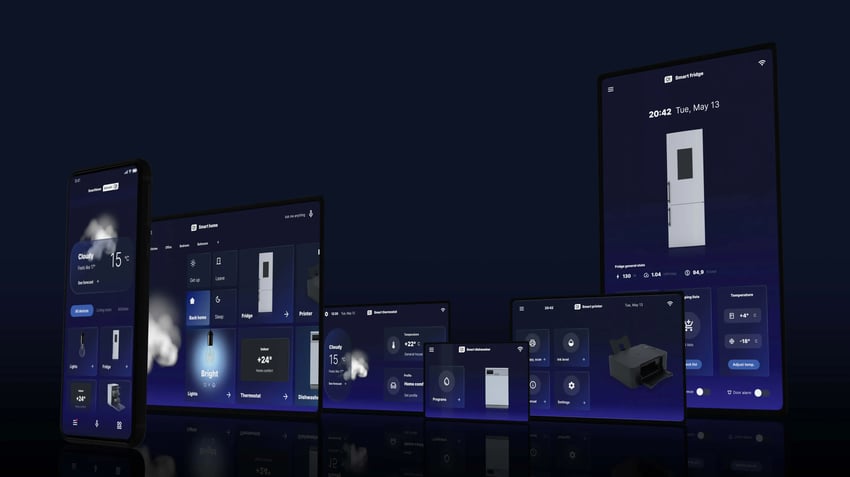How the Usability of Medical Devices Can't Be Separated From Their Safety or Security
Medical device developers have traditionally viewed usability, safety, and security as separate areas of concern. In the past, human factors testing and usability were not considered essential components of the design process either. However, as technology advances, there has been a growing recognition of the importance of these factors in product development and, most of all, in ensuring the safety and efficiency of medical devices.
By Nghi Dang

Usability focuses on how easily users interact with the device or product, including user interfaces, ergonomics, and workflow efficiency. In unregulated industries, it may be more familiar to prioritize adopting new technology over safety and security. However, in highly regulated industries such as the medical industry, the focus must be on ensuring that the devices/products are safe and effective. This distinction means that the usability of medical devices or products is not just about convenience but is intrinsically linked to preventing misuse, and effective user adoption of the features. In our whitepaper on "Leveraging Human Factors Testing to Develop a Better MedTech Product," we describe how the medical sector has begun to see usability more significantly by observing that more than a third of medical device incidents involved a use error, and more than half of all device recalls for design problems involve the user interface. This drives their recognition of human factors risks and their understanding that usability cannot be separated from safety and security aspects.
A complex, clumsy, or non-intuitive device will likely not be well adopted, regardless of its technical innovations. An investigation into the relationship between EHR (electronic health records) usability and professional dissatisfaction found a strong association between the health record system's low usability score and increased nurse burnout. This finding prompted a need for user-centered design and a re-evaluation of the interface to enhance user experience. In another example, patients have reported being disturbed by loud alarms from infusion pumps while nurses struggle to silence the noise, diverting their attention from comforting the patient. A device that better categorizes the severity of issues and related alarms could have significantly reduced stress for patients and device users.

The Evolution of Medical Device Usability
The intertwining of usability, safety, and security in medical devices is becoming increasingly recognized as crucial for patient welfare. Previously, when topics were treated separately, optimizing one aspect without compromising others was challenging. It resulted in creating silos, where different teams working on each element lacked collaboration and communication. Moreover, reactive measures were only taken after the devices had already been in use.
Regulatory frameworks and guidelines, including IEC 62366-1 and directives from the European Medical Device Regulation (MDR) and the US Food and Drug Administration (FDA), are now emphasizing the importance of integrating usability engineering into the development process. Risk management strategies are evolving to mitigate usability risks by understanding user interactions with medical devices. Human factors, or ergonomics, refer to studying all factors that make it easier for individuals to perform work effectively and safely. Although human factors have been recognized in aviation and manufacturing, they have only recently gained prominence in the medical and healthcare sectors. Nowadays, the users of these devices are not only trained professionals, emphasizing the need to create more adaptable and accommodating designs for a broader range of users. With the increase of wearable medical devices and medical devices used outside the hospital environment, there is also an increase in the diversity of users from various backgrounds. The devices and products should thus be designed with human factors in mind so that they can be used by healthcare workers of all levels of experience, from beginners to seasoned professionals, as well as users who might be the patients themselves or their family members.
All these changes indicate a growing demand for a holistic approach to designing medical devices and products that are not only effective but also secure and user-friendly.
Watch our Visionary Voices of Tech webinar, "Revolutionizing Healthcare: The Future of Intuitive Medical Devices", and hear from experts from Clarius, Witekio, and Ezurio!

Safety in Medical Devices
Safety and usability are inextricably linked in the medical sector, as Roger Mazzella, Senior Product Lead at Qt Group, highlights in our "Next Level User Experience for Medical Devices" on-demand webinar. Usability directly impacts safety by reducing user errors and making interfaces intuitive and easy to use, reducing fatigue and enhancing accuracy. Safety ensures patient well-being and builds trust between patients, healthcare providers, and manufacturers. A widely adopted and comfortably used device is inherently safer, as familiarity and comfort with technology can significantly decrease misuse or errors.
Regulatory compliance and safety are imperative in the highly regulated medical sector. The medical industry has mission-critical applications, where programs and systems allow little space for fixing or maintenance because any failure would severely impact patients. Critical operations demand uncompromising performance and reliability of software and medical devices. This also means addressing functional safety in the medical sector.
Poorly designed user interfaces that result in incorrect settings or misuse, excessive false alarms leading to alarm fatigue, which also falls under user interface errors, and cybersecurity vulnerabilities are some of the safety concerns with medical devices. Besides, connected devices are more widely used with Internet of Things (IoT) technology but are also more vulnerable to hacking, which can compromise patient data and safety.

Security Concerns in the Digital Age
Medical devices are now considered critical infrastructure. Earlier, their cybersecurity was included in the general medical device risk assessment. However, in recent years, the EU Legislation, MDR, FDA, and other global ministries of health have emphasized cybersecurity risk as a separate concern, issuing specific guidance and cybersecurity requirements tailored to the medical industry. This has led to an increased focus on cybersecurity within the sector. Before the pandemic, manufacturers only connected medical devices when necessary because they were "nice to have" in many situations. After the pandemic, as remote care quickly became a requirement, all devices must be connected, making cybersecurity a priority.
The complex healthcare environment makes reducing cybersecurity risks challenging, as balancing interoperability with security is a delicate task. One challenge for medical device interoperability is the need for a well-defined reference implementation for existing device interface standards. The lack of standardized protocols and interfaces hinders seamless data exchange, resulting in data silos. This fragmentation makes it challenging to create a comprehensive and unified patient record.
Secondly, medical devices come from various suppliers; one vulnerable component can compromise the entire system. Furthermore, many healthcare organizations rely on legacy systems, and upgrading or replacing them to meet modern interoperability demands can be costly and resource-intensive.

Cybersecurity breaches extend beyond direct safety concerns, encompassing operational downtimes, ransomware attacks, data breaches compromising patient privacy, and reputational damage for manufacturers and healthcare providers. Data breaches have increased since 2010, and health data is targeted due to its immutability and sensitivity. Cyberattacks can disrupt hospital operations and critical devices, compromising patient safety and privacy.
Another challenge in cybersecurity for medical devices and products is designing user interfaces (UIs) that are attractive and modern while also being secure and safe. This highlights the need for medical devices with user-friendly interfaces, as ease of use can significantly impact user adoption and effectiveness. Some key aspects include robust access control mechanisms, clear error messages and feedback on successful actions, and intuitive UIs to ensure usability and successful feature adoption. UI design of medical devices/products/software should be smooth for users, helping them avoid inadvertently compromising the security for efficiency.
Read the article: 'Saving Lives with UX Design'

The Intersection of Usability, Safety, and Security
The development of medical devices requires a multifaceted approach that addresses usability, safety, and security. The MDR emphasizes the importance of usability, requiring manufacturers to demonstrate compliance with usability standards for all medical devices. Devices should be suitable for their intended purposes, including the intended users, environment, and performance under normal conditions. Ergonomic features, technical knowledge, and physical conditions of intended users should also be considered when designing a device. The IEC 62366-1 standard states that if the usability engineering process has been followed, the usability of the medical device related to safety is presumed acceptable. Usability engineering is intertwined with other aspects of device development, such as risk management and quality management. The FDA provides guidance to manufacturers on incorporating human factors and usability engineering into medical device design. They also recognize the risks posed by connected medical devices, hence the existence of the FDA Draft guidance on cybersecurity.
Moreover, the usability of medical devices includes a risk factor attributed to user training. Intuitive UIs play a significant role in this regard, especially concerning the length of the learning curve. These days, users expect a smartphone-like UI that emphasizes modern user experiences. User experience is significant in medical device application development, ensuring smooth user adoption in the medical sector. Lower user adoption or unintuitive design can cause mental load and emotional distress for healthcare professionals and affect patients' care.

Designing for the Future of Medical Devices and Software: How Qt Can Help
The holistic approach to designing medical devices involves creating devices that are clinically effective, user-friendly, accessible to a diverse user base, and designed with a deep understanding of the varied contexts in which the devices will be used. This approach prioritizes user experience to ensure devices meet the needs of all stakeholders in the healthcare ecosystem. Qt, with its dynamic development framework and tools, gives medical device manufacturers that holistic approach.
Qt provides a rich set of libraries and tools that enable the development of user interfaces and the underlying logic for medical devices. This includes support for 2D and 3D graphics, touch and gesture input handling, and integration with various hardware components. These capabilities allow for the creation of intuitive and responsive interfaces that enhance user interaction with medical devices.
A medical device manufacturer must provide evidence to be regulatory compliant. Qt offers the necessary functionality, performance, and support to operate within its specifications. Qt provides documentation and transparency into its development process, product performance, and internal validation and testing to help manufacturers satisfy their IEC 62304 requirements, FDA, EU, and other global certification efforts. The documentation includes but is not limited to Qt's Quality System, development process, proof of internal testing, quality assurance practices, test reports, and standards certificates.

The Qt framework also supports cross-platform development, enabling the same codebase to be used across different operating systems and hardware platforms. This is particularly beneficial for medical device manufacturers aiming to streamline their development process and ensure consistency in the functionality and appearance of their devices across various platforms.
The Qt Safe Renderer is additionally highly useful for medical devices and is certified to IEC 62304. It ensures that safety-critical information is rendered reliably, even in system malfunctions. This is crucial for patient monitoring systems, diagnostic equipment, and other medical devices where the accurate and uninterrupted data display can be life-saving. Qt supports a dual-processor architecture for enhanced safety, where safety-critical functions can be isolated on a separate processor. This approach minimizes the risk of failures in the main application, affecting the functionality of critical safety components.

Qt further provides tools for medical device development's design and quality assurance (QA) phases. For design, tools like Qt Design Studio allow designers and developers to collaborate closely to create and iterate on the UI/UX design seamlessly. This can accelerate the development process and ensure that the end product aligns closely with user needs and safety requirements. For quality assurance, Qt offers comprehensive QA tooling for compliance with coding guidelines (Axivion), code coverage (Coco), and early verification of the software functions (Squish) that support the development of automated tests, helping to ensure that the software meets all functional safety requirements. This is crucial in the medical device domain, where software reliability and compliance with regulatory standards are mandatory. The QA tools can also test software that is not built with Qt. Qt further uses its QA tools to test for cybersecurity vulnerabilities along with 3rd party assessments internally.

Besides, Qt Insight, a cloud-based analytics tool specifically designed to offer insights on the usage of applications or devices, will also be valuable for the medical industry to validate your product’s functionality. Qt Insight analytics can enhance the medical device/software design phase by enabling product managers to make informed decisions based on user interactions, thus improving usability and effectiveness. The tool can also help with field testing optimization and onboarding optimization. The latter is vital since a smooth first-use experience can increase adoption rates and ensure the product is used to its full potential. It's also essential to understand how features are adopted and used. Analytics can identify which features are most beneficial and which may require redesign or better integration into clinical workflows. Understanding the user interface paths can also highlight areas for improvement to make the product more intuitive for medical professionals. Additionally, medical device manufacturers can use these vital analytics when reporting on the required post-market surveillance of their devices.
Watch the on-demand webinar: 'Top 5 UI/UX Trends Shaping the Future'

Harmonizing Usability, Safety, and Security: The Keystone for Future-Proof Medical Devices
An integrated approach to the medical device design acknowledges that usability is crucial in the safe and secure application of medical technologies in real-world settings. Industry stakeholders, including manufacturers, designers, and regulatory bodies, must prioritize this approach. The integrated approach not only promotes innovation but also enhances the reliability and effectiveness of medical devices. Furthermore, it paves the way for more user-friendly technologies seamlessly integrated into healthcare practices, reducing the likelihood of user errors and increasing the overall quality of patient care. As our whitepaper on "Safe and Effective Medical Device Development With Qt" has pointed out, developers in the medical industry can design a device or product that is functionally safe, modern, and attractive at once. With careful planning and work, it is feasible to meet high safety standards without compromising on the user interface design.
Collaboration among interdisciplinary teams is necessary to foster a comprehensive understanding and implementation of usability, safety, and security measures. Secure design principles should be incorporated from the outset to mitigate potential cybersecurity vulnerabilities. Addressing concurrently the usability, safety, and security aspects streamlines the development process, making it more efficient and effective.

